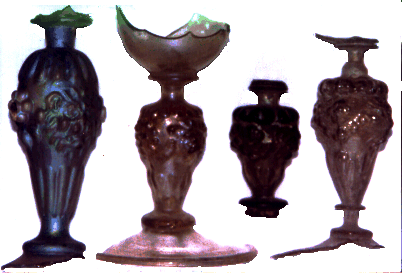
The glasses in this group have much in common with those in group two, so these notes should be read in conjunction with those for that group. They are the most enduring of seventeenth century glass styles, apparently in production for the first two-thirds of the century. The two-groups seem to embody the developing split in British society, these stems being the ornate 'Cavalier' design compared with the plain-functional 'Roundhead' design of the cigar stems. Remains of these glasses are found on civil-war sites of the 1640s, both used by Royalist and Parliamentary households. These stems also feature in the 'Fire-of-London' sites of 1666. Moulded stems were introduced in the sixteenth century, but it is not clear to what extent they were made in England before the last decade of that century.

This illustration shows the typical variation between stems with lion-mask mouldings. The size range is shown by the contrast between that on the left (from a beer-glass) and that right of centre. The stem left of centre, probably from a wine glass, shows clear evidence of surface guilding. The stem on the right is probably an import from Venice, shown by the clarity of the glass and the fineness of the detail. Stems have been found with evidence of period repairs (described in group two).
Where significant portions of feet have been recovered, these usually have folded rims, although plain-edged feet have been found. Decorated bowls are quite common, with trailing, reed moulding or dimple moulding. At least one glass has been found with a 'Greene' type bucket bowl with a moulded basal cordon. At this stage there is no reliable way of distinguishing an early glass from a later one.
This page talks about this sort of glass and includes a classification of all the variations we know about. If you know of any other variations please let us know, so we can keep the list up-to-date.
For notes on the 17th Century glass classification used Click here. In common with other early seventeenth century glasses, the basic form of this stem includes a strengthening merese at both the stem-to-bowl and the stem-to-foot junctions.